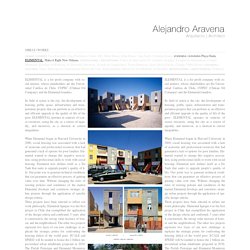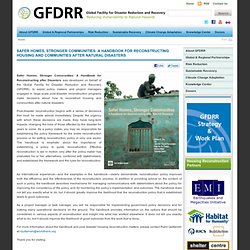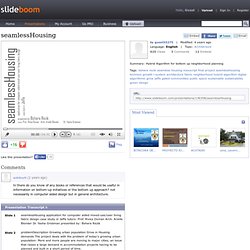

Incremental Housing. International House Sizes. Housing Prototypes. Most building types can be readily researched in books and magazines.

Because of the large worldwide production and very dynamic nature of housing construction, however, it is very difficult to track new developments in housing design. Books quickly obsolesce and few libraries have the resources to even subscribe to the range of periodicals necessary to track new developments. The advantage of web-based material is that it offers a dynamic database accessible by anyone with a computer.
It can be periodically revised and thus allows the researcher to continually update their knowledge about a particular subject. HousingPrototypes.org was conceived to fill the need for a dynamic, interactive database about housing. HousingPrototypes.org is published free on the Internet as an information service. The Changing Face of Housing – Your Views from #citytalk. This post is also available in: Chinese (Traditional) Last Monday, a hoard of urbanists sat in front of their computers to discuss the changing face of housing as part of our second #citytalk tweetchat (no idea what a tweetchat is?

– more info here). Hosted by This Big City and Future Cape Town, our second chat featured Kasey Klimes of Secret Republic and Gavin Silber of Cape Town’s Social Justice Coalition as special guests, alongside countless other eager tweeters. The discussion was even more fast-paced than our first chat, with the eight questions we discussed reaching over 44,000 people. Don’t worry if you missed out – we’ve taken a look back over the chat to share our favourite comments. We kicked things off by asking how housing is changing in your city, with @JeremySenko, @urbanchords and myself noting that newer developments were producing smaller houses in Vancouver, Chicago and London, respectively. Promoting Innovative Housing Policy and Practice. Welcome to the Brisbane Housing Company » Brisbane Housing Company. Alejandro Aravena. ELEMENTAL is a for profit company with social interest, whose shareholders are the Universidad Católica de Chile, COPEC (Chilean Oil Company) and the Elemental founders.

Its field of action is the city: the development of housing, public space, infrastructure and transportation projects that can perform as an effective and efficient upgrade in the quality of life of the poor. ELEMENTAL operates in contexts of scarce resources, using the city as a source of equality, and moreover, as a shortcut to correct inequalities. When Elemental began in Harvard University in 2000, social housing was associated with a lack of economic and professional resources that had generated a lack of options for poor families.
Elemental wanted to change this negative association, using professional skills to work with social housing. SCALE. SPEED. SCALE. SPEED. ELEMENTAL. Safer Homes, Stronger Communities. Safer Homes, Stronger Communities: A Handbook for Reconstructing after Disasters was developed on behalf of the Global Facility for Disaster Reduction and Recovery (GFDRR), to assist policy makers and project managers engaged in large-scale post-disaster reconstruction programs make decisions about how to reconstruct housing and communities after natural disasters.

Post-disaster reconstruction begins with a series of decisions that must be made almost immediately. Despite the urgency with which these decisions are made, they have long-term impacts, changing the lives of those affected by the disaster for years to come. As a policy maker, you may be responsible for establishing the policy framework for the entire reconstruction process or for setting reconstruction policy in only one sector. SeamlessHousing. SeamlessHousing text.

The method chosen in order to deal with the problem is creating a mechanism of growing architecture as a planning tool. A workflow I called "hybridAlgorithm" was developed, uniting the human architect with the computer in order to create a logical hierarchical growth mechanism. As the site is inserted into the system, "Forces" are defined by the user (the Architect) as lines, volumes and points, giving them strengths and decay methods. This resembles the conventional planning method of defining a "total scheme" for the site, only now this scheme becomes a diagram of statistical powers affecting each point of the site. As points in the site are sampled, one can see the effect of all the forces around it, and hence statistics for further growth of the system are defined.